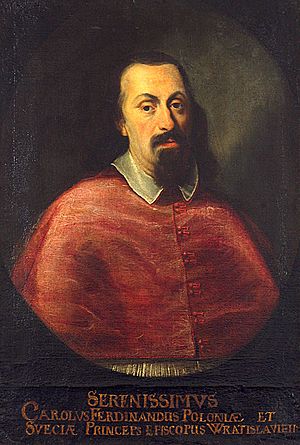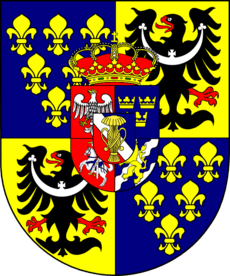Karol Ferdynand Vasa facts for kids
Quick facts for kids Karol Ferdynand Vasa |
|
|---|---|
| Bishop of Wrocław Bishop of Płock Duke of Opole |
|

Portrait by Daniel Schultz
|
|
| Born | October 13, 1613 Warsaw, Poland |
| Died | May 9, 1655 (aged 41) Wyszków, Poland |
| Burial | Jesuits' Church, Warsaw |
| House | Vasa |
| Father | Sigismund III Vasa |
| Mother | Constance of Austria |
| Religion | Roman Catholic |
Prince Charles Ferdinand Vasa (born Karol Ferdynand Waza) was a Polish prince. He was born in Warsaw on October 13, 1613. He passed away in Wyszków on May 9, 1655.
He held important church positions. He served as the Bishop of Wrocław starting in 1625. Later, he became the Bishop of Płock in 1640. He was also the Duke of Opole from 1648 until his death.
Contents
Life of Prince Charles Ferdinand
Early Life and Church Roles
Charles Ferdinand was the fourth son of King Sigismund III Vasa and Queen Constance of Austria. He grew up in Warsaw at the royal court. In 1624, he received special permission from Pope Urban VIII. This allowed him to become a canon (a type of priest) in Wrocław.
On May 3, 1625, he was appointed the Bishop of Wrocław. He was only 12 years old at the time. This appointment was helped by Ferdinand II, Holy Roman Emperor. The Pope approved this on October 22, 1625. Even though he was so young and not yet a fully ordained priest, he officially became bishop in January 1626.
In 1629, he added the Prudnik area to the Roman Catholic Archdiocese of Wrocław. Before this, Prudnik was part of another church area.
Inheritance and Royal Court
After his mother died in 1631, Charles Ferdinand and his brother John Casimir inherited the rich city of Żywiec. During the rule of his brother, King Władysław IV Vasa, Charles Ferdinand mostly lived in Warsaw.
Even though he was close to the royal family, he was not very interested in politics. He did not try to gain more power in the government. From 1632 to 1648, he focused on managing church affairs and money. He also collected many church benefits.
In 1640, he was named the Bishop of Płock. As he got older, Charles Ferdinand decided not to become a fully ordained priest. Instead, he let other important bishops and priests manage the daily work of the Archdioceses of Wrocław and Płock.
Candidate for King
After King Władysław IV Vasa died in 1648, Charles Ferdinand was considered a possible new king of Poland. His brother, John II Casimir Vasa, was also a candidate. Charles Ferdinand wanted to take strong action to stop a civil war happening in Polish-controlled Ukraine.
He had the support of many senators and bishops in the Polish Parliament (called the Sejm). Many nobles from Ukraine also supported him. However, some groups, like Protestants and Lutherans, did not agree with his policies. The nobility of the Grand Duchy of Lithuania also opposed him. They worried about stronger Catholic influence.
Later Life and Legacy
Charles Ferdinand lost the election for king. His brother, John Casimir, became the new king. As a gift, John Casimir gave Charles Ferdinand the Duchy of Opole and Racibórz. After this, Charles Ferdinand stepped away from public life.
He moved to the church lands in Płock, in a region called Mazovia. His main home was a large Renaissance castle in Brok. In 1651, he took care of Michael Korybut Wiśniowiecki, who later became King Michael I. Charles Ferdinand paid for Michael's travels and education in Europe's best schools.
Charles Ferdinand Vasa died on May 9, 1655, in Wyszków. He was buried in the Jesuit Church in Warsaw.
He left behind a very large fortune. Most of it was used to build and support churches across the country. His brother, King John Casimir, inherited the rest. This money and land helped King John Casimir pay for troops during the Polish-Swedish War. The Duchy of Silesia also gave the king a safe place to stay when he had to leave Poland in 1655.
Patron of Arts
Charles Ferdinand was a great supporter of art. He also supported the Society of Jesus (Jesuits). He had a huge silver altar built for the Jesuit Church in Warsaw.
In the 1640s, a royal architect named Giovanni Battista Gisleni built a palace for him. This palace was located on the northern wall of the Royal Castle in Warsaw. Sadly, it was later attacked and destroyed by Swedish and German forces in the 1650s during the "Deluge" war. He also owned a large wooden palace in Wyszków.
Gallery
-
He rebuilt the Castle in Otmuchów, after devastation during the Thirty Years' War.
See also
 In Spanish: Carlos Fernando Vasa para niños
In Spanish: Carlos Fernando Vasa para niños








